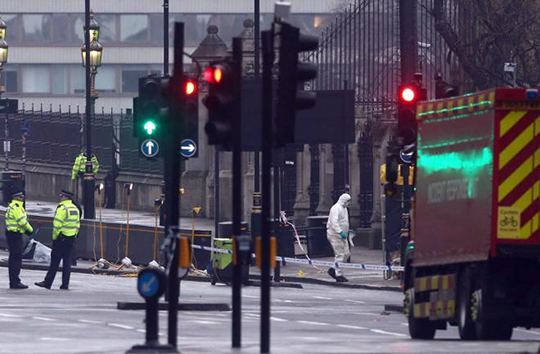London, Mar 23: Eight people were arrested in raids across London and Birmingham today after a terror attack on the UK Parliament in the heart of Westminster killed four people, including the ISIS attacker who was inspired by "Islamist ideology" and known to British secret services.

"We are not afraid...An act of terrorism tried to silence our democracy, but today we meet as normal," Prime Minister Theresa May told the packed House of Commons which reopened today with a minute's silence a day after the attack.
"What I can confirm is that the man was British born and that – some years ago – he was once investigated in relation to concerns about violent extremism. He was a peripheral figure," she told sombre-looking lawmakers.
Three people were killed and 40 injured when the attacker mowed down pedestrians on a bridge and stabbed to death a police officer outside parliament complex before being shot dead by Scotland Yard officers yesterday.
"It is still believed that this attacker acted alone, and the police have no reason to believe there are imminent further attacks on the public. His identity is known to the police and MI5, and when operational considerations allow, he will be publicly identified. Our working assumption is that the attacker was inspired by Islamist ideology," May said.
Meanwhile, the ISIS on its propaganda news agency 'Amaq' claimed responsibility, saying a "Soldier of the Caliphate" carried out the attack on the British Parliament.
"The operation was carried out in response to calls to target coalition countries," it said in a statement.
The Prime Minister confirmed that eight people have been arrested during raids across London and Birmingham following the attack on the Palace of Westminster in London, which houses Britain's Parliament and the iconic Big Ben.
In her message to the police, British Queen Elizabeth II said, "My thoughts, prayers and deepest sympathy are with all those who have been affected by yesterday's awful violence."
May said the threat level to the UK has been set at 'severe' – meaning an attack is highly likely – for some time. This is the second highest threat level. The highest level 'critical' means there is specific intelligence that an attack is imminent.
"As there is no such intelligence, the independent Joint Terrorism Analysis Centre has decided that the threat level will not change in the light of yesterday's attack," she said.
Giving details known about the attack, May said a single attacker drove his vehicle at speed into innocent pedestrians who were crossing Westminster Bridge, killing two people and injuring around 40 more, of which 29 were hospitalised.
The attacker then left the vehicle and approached a police officer at Carriage Gates of Parliament, attacking him with a large knife, before he was shot dead by an officer.
In addition to 12 Britons admitted to hospital, the injured include three French children, two Romanians, four South Koreans, one German, one Pole, one Irish, one Chinese, one Italian, one American and two Greeks.
"There was no prior intelligence of attacker's intent – or of the plot. Intensive investigations continue," May said.
She also paid tribute to the security services and the police officer who lost his life in the attack.
"Yesterday we saw the worst of humanity, but we will remember the best. We will remember the extraordinary efforts to save the life of Police Constable Keith Palmer. He was every inch a hero," she said.
Scotland Yard Acting Deputy Commissioner and Head of Counter Terrorism Mark Rowley said the investigation was at a critical stage and the identity of the attacker was not being released as the ongoing investigation tries to piece together the suspect's "motivations, his preparation and associates".
He urged the public to use their instincts and report anything suspicious, saying the Met Police will be working round the clock and all annual leave has been cancelled.
"We must not allow terrorists to create discord, distrust and fear. The police stand with all communities," Rowley said.
Overnight, West Midland Police officers stormed a second-floor flat in the city believed to be the residence of the knife-wielding attacker and led away people in handcuffs.
It has also emerged that the car used in the attack was reportedly hired from Solihull area of Birmingham.
The flag at New Scotland Yard premises in London is flying at half-mast following the attack, which claimed the life of one of their officers who was on guard at Parliament.
Mayor of London Sadiq Khan today invited all Londoners and visitors to the capital to a candlelit vigil in Trafalgar Square to show solidarity with the victims of theattack.




Comments
Add new comment